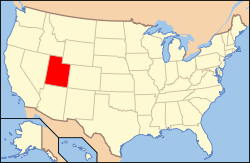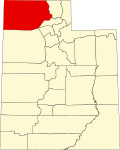Mantua, Utah
 From Wikipedia - Reading time: 11 min
From Wikipedia - Reading time: 11 min
Mantua, Utah | |
|---|---|
 | |
 Location of Mantua within Box Elder County and within the State of Utah | |
 Location of Utah within the United States | |
| Coordinates: 41°29′51″N 111°56′05″W / 41.49750°N 111.93472°W | |
| Country | United States |
| State | Utah |
| County | Box Elder |
| Settled | 1863 |
| Incorporated | 1911 |
| Named after | Mantua, Ohio |
| Government | |
| • Type | Mayor/Council |
| • Mayor | Terry Nelson[1] |
| Area | |
• Total | 5.70 sq mi (14.8 km2) |
| • Land | 4.91 sq mi (12.7 km2) |
| • Water | 0.79 sq mi (2.0 km2) |
| Elevation | 5,164 ft (1,574 m) |
| Population (2020) | |
• Total | 1,090 |
| • Density | 196.25/sq mi (75.77/km2) |
| Time zone | UTC-7 (Mountain Time Zone) |
| • Summer (DST) | UTC-6 (MDT) |
| ZIP code | 84324 |
| Area code | 435 |
| FIPS code | 49-47840[4] |
| GNIS feature ID | 2412947[3] |
| Website | www |
Mantua (/ˈmæntəweɪ/ MAN-tə-way or /ˈmænəweɪ/ MAN-ə-way) is a town on the eastern edge of Box Elder County, Utah, United States.[3] The population of the town was 1,090 at the 2020 census.
History
[edit]
Mantua was settled in the mid-19th century when members of the Church of Jesus Christ of Latter-day Saints were sent by Lorenzo Snow to the valley to grow flax. The first group arrived in Mantua in 1863 (although a sign at the main entry route states "Founded 1864"),[5] and were all émigrés from Denmark led by Hans Jens Jensen. Snow was from Mantua, Ohio, and the town was named after the Ohio community in his honor.[6] Due to Danish pronunciation the town's pronunciation was changed to "man-away" unlike Ohio's ("man-tooway").[7] Prior to receiving its current name, the community was called Box Elder Valley, Copenhagen, Flaxville, Geneva, Hunsaker Valley, Little Copenhagen, and Little Valley.[8][9]
Geography
[edit]Mantua lies at the head of Box Elder Canyon on the northern, western, and southern sides of the Mantua Reservoir. According to the United States Census Bureau, the town has a total area of 5.6 square miles (15 km2), of which 4.9 square miles (13 km2) are land and 0.7 square miles (1.8 km2) (13.21%) is water.
Climate
[edit]According to the Köppen Climate Classification system, Mantua has a dry summer continental climate, abbreviated "Dsa" on climate maps.[10]
| Census | Pop. | Note | %± |
|---|---|---|---|
| 1870 | 184 | — | |
| 1880 | 356 | 93.5% | |
| 1890 | 337 | −5.3% | |
| 1900 | 350 | 3.9% | |
| 1910 | 377 | 7.7% | |
| 1920 | 354 | −6.1% | |
| 1930 | 314 | −11.3% | |
| 1940 | 319 | 1.6% | |
| 1950 | 271 | −15.0% | |
| 1960 | 275 | 1.5% | |
| 1970 | 413 | 50.2% | |
| 1980 | 484 | 17.2% | |
| 1990 | 665 | 37.4% | |
| 2000 | 791 | 18.9% | |
| 2010 | 687 | −13.1% | |
| 2019 (est.) | 963 | [11] | 40.2% |
| US Decennial Census[12] | |||
Demographics
[edit]As of the 2000 United States Census,[4] there were 791 people, 218 households, and 189 families in the town. The population density was 162.5 people per square mile (62.7/km2). There were 231 housing units at an average density of 47.5 per square mile (18.3/km2). The racial makeup of the town was 96.33% White, 0.63% African American, 0.51% Native American, 0.25% Asian, 0.51% from other races, and 1.77% from two or more races. Hispanic or Latino of any race were 0.88% of the population.
There were 218 households, out of which 52.8% had children under the age of 18 living with them, 79.4% were married couples living together, 5.0% had a female householder with no husband present, and 13.3% were non-families. 12.4% of all households were made up of individuals, and 5.5% had someone living alone who was 65 years of age or older. The average household size was 3.63 and the average family size was 4.01.
The town population contained 38.2% under the age of 18, 10.1% from 18 to 24, 23.3% from 25 to 44, 20.1% from 45 to 64, and 8.3% who were 65 years of age or older. The median age was 30 years. For every 100 females, there were 108.7 males. For every 100 females age 18 and over, there were 103.8 males.
The median income for a household in the town was $60,234, and the median income for a family was $61,964. Males had a median income of $42,100 versus $26,875 for females. The per capita income for the town was $17,798. About 0.5% of families and 1.7% of the population were below the poverty line, including 2.1% of those under age 18 and 3.4% of those age 65 or over.
Mantua Reservoir
[edit]There are several natural springs in the valley that feed into the reservoir. At the south end of the valley is Maple Spring. Its water flows northward into the reservoir via Maple Creek. At the west base of the Little Knoll on the east side of the reservoir is a spring that is pumped into the lake. Further north is another spring flowing from the east mountain. North of town at the base of Round Hill is the north spring that runs south. On the west of town is Halling Springs which runs south east into the northern end of the reservoir. Brigham City as of 2020 diverts most of this water into culverts for fresh drinking water, leaving barely enough water in the creek to water livestock on its way to the reservoir. In 1959–60, Brigham City (located at the mouth of Box Elder Canyon) obtained land at the center of the valley, and raised an earthen dam on Big Creek and a dike around most of the perimeter to create Mantua Reservoir – also known as Brigham City Reservoir. Brigham City continues to own the reservoir and adjoining land, and operates the reservoir.[13] The reservoir is open to public access, including ice fishing during cold seasons.
Government
[edit]Mantua is considered to be a speed trap.[14][15] In 1997, its two police officers issued over 1,300 speeding tickets, amounting to fines of approximately $60,000, or more than half of the city's total yearly revenue.[16] In 2014, it issued over 2,100 traffic tickets, amounting to approximately $220,000 in fines, or more than one-third of total yearly revenue.[17] The sole full-time police officer (and later mayor) objected to the term "speed trap" as he said he did not hide his truck, and fatal accidents had decreased since he began patrolling. Most tickets are issued along the town's section of combined US Highway 89/91.[16] However, a state legislator[which?] countered that reduced speed limits, installed barriers, and rumble strips have reduced traffic fatalities, calling into question the justification for such a large ratio (compared to number of residents) of issued traffic tickets in the area.[17]
In January 2020, Mantua again came under fire for unethical revenue sources, as they were issuing parking tickets on land not owned by the city, and with signage knowingly being installed wrong. They had also increased their budget for parking fines 24% over the previous year.[18] When asked about this, the city claimed that it loses money on parking tickets which is in contrast to the rest of the state. Brigham City owns the land which the tickets were written on, and the Mantua Police Department was operating with unapproved Brigham City employees telling them when to issue citations.
In 2021, the town prosecutor filed Class C misdemeanor charges against about a dozen residents for failing to license their dogs even though the dogs had died. The police chief had signed the summons in which he stated that there was evidence of the violation, but was unable to produce it for the trial. The town council subsequently changed the ordinance to make failure to obtains a dog license an infraction rather than a criminal misdemeanor, bringing the town into compliance with Utah state law, which permits a misdemeanor only for repeated offenses or in situations that are a threat to public health or safety.[19]
See also
[edit]References
[edit]- ^ Leonard, Collin (October 18, 2024). "Mantua residents pack town hall after arrest of 76-year-old by police chief". KSL.com. Retrieved October 19, 2024.
- ^ "2019 US Gazetteer Files". US Census Bureau. Retrieved August 7, 2020.
- ^ a b c U.S. Geological Survey Geographic Names Information System: Mantua, Utah
- ^ a b "US Census website". United States Census Bureau. Retrieved January 31, 2008.
- ^ "New Mantua police chief was fired by West Jordan Police". Salt Lake Tribune. May 11, 2021. Retrieved May 11, 2021.
- ^ Jenson, Andrew (1920). "Origin of Western Geographic Names". The Utah Genealogical and Historical Magazine. 11 (2): 83.
But in 1864 the settlement was named Mantua, after Mantua, Portage County, Ohio, the birthplace of President Lorenzo Snow.
- ^ Cannon-O'Day, Kelly (October 7, 2023). "Utah pronunciation guide: How to say odd Utah names and learn the history behind them". Salt Lake Tribune. Archived from the original on October 12, 2023.
- ^ Van Cott, John W. (1990). Utah Place Names: A Comprehensive Guide to the Origins of Geographic Names: A Compilation. Salt Lake City: University of Utah Press. p. 244. ISBN 978-0-87480-345-7. OCLC 797284427.
- ^ "Town of Manuta: Mantua History". townofmantua.com. Town of Mantua. Retrieved March 17, 2018.
- ^ "Mantua, Utah Köppen Climate Classification (Weatherbase)". Weatherbase. Retrieved October 2, 2019.
- ^ "Population and Housing Unit Estimates". US Census Bureau. May 24, 2020. Retrieved May 27, 2020.
- ^ "Census of Population and Housing". census.gov. US Census Bureau. Retrieved June 4, 2015.
- ^ "Mantua Reservoir" (PDF). Bear River Information. 1994. Retrieved May 11, 2021.
- ^ Davidson, Lee (February 24, 2016). "Utah Senate votes to crack down on Mantua 'speed trap' in Box Elder County: SB100 would allow no city to generate more than 25% of its budget from speeding fines". The Salt Lake Tribune. Salt Lake City: Huntsman Family Investments, LLC. Retrieved March 17, 2018.
- ^ Dean, Tania; Headrick, Mike. "Most likely spots in Utah for speeding tickets". KSL TV. Archived from the original on February 26, 2019. Retrieved February 26, 2019.
- ^ a b "Mantua boasts mean speed trap". Deseret News. Salt Lake City: Deseret Digital Media. The Associated Press. March 10, 1998. Archived from the original on October 18, 2012. Retrieved March 17, 2018.
- ^ a b Gefre, Clayton (January 30, 2016). "Mantua fuming over speed trap bill". The Herald Journal. Logan, Utah: Adams Publishing Group. Retrieved March 17, 2018.
- ^ Headrick, Mike; St. Clair, Cindy (January 22, 2020). "KSL Investigates: Confusing parking signs lead to tickets". KSL TV. Archived from the original on January 22, 2020. Retrieved April 20, 2021.
- ^ "Utah town filed criminal charges against residents who didn't get licenses for dead dogs". KUTV. December 17, 2021. Retrieved December 21, 2021.
External links
[edit]![]() Media related to Mantua, Utah at Wikimedia Commons
Media related to Mantua, Utah at Wikimedia Commons
 KSF
KSF